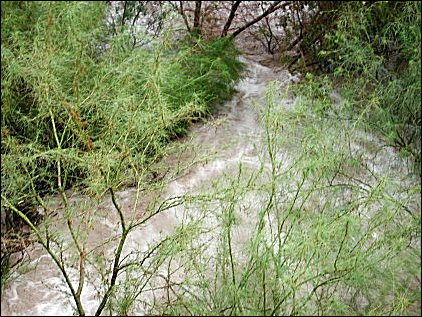

Sloping ground, rocks, stickers, nasty crawling things—no wonder many Chihuahuan Desert novices spread bedrolls on the smooth, shiftable sand of a dry arroyo. What better place could there possibly be? In the rainy season, just about anywhere! If its raining you might think about getting to higher ground. But if the stars are shining brightly overhead, and all seems right with the world, rain may be the last thing on your mind—and this can be disastrous. Many arroyos start in distant mountains, and a thunderstorm near its head may be too distant to even impinge on consciousness.
With little vegetation to slow runoff and dry soil unable to quickly
absorb a downpour, an arroyo can fill with water in minutes. The sleeping camper, miles
downstream, may awaken to a dull roar that quickly rises to the level of thunder as a
wall of water overwhelms all in its way. With luck, one might escape up slope as the
aptly named flash flood, starlight glinting serenely from its surface, carries away all
left behind.

Contributor: Arthur H. Harris, Laboratory for Environmental Biology, Centennial Museum, University of Texas at El Paso.
Desert Diary is a joint production of the Centennial Museum and KTEP National Public Radio at the University of Texas at El Paso.

Flood waters sweeping through a normally dry arroyo. Photograph by A.H. Harris.